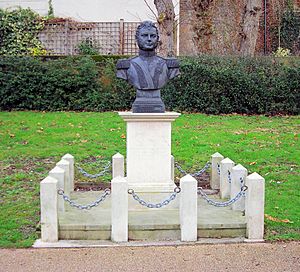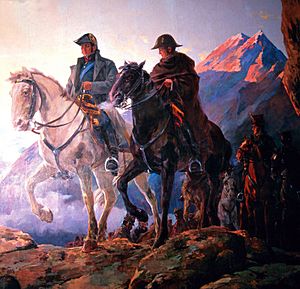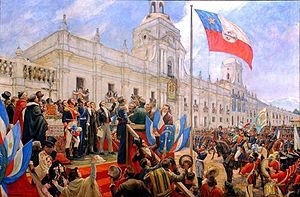Bernardo O'Higgins facts for kids
Quick facts for kids
Bernardo O'Higgins
|
|
|---|---|

Portrait by José Gil de Castro
|
|
| Supreme Director of Chile | |
| In office 17 February 1817 – 27 January 1823 |
|
| Preceded by | José Miguel Carrera |
| Succeeded by | Ramón Freire |
| Commander-in-Chief of the Chilean Army | |
| In office 27 April 1819 – 27 January 1823 |
|
| Preceded by | José de San Martín |
| Succeeded by | Ramón Freire |
| In office 27 November 1813 – 2 September 1814 |
|
| Preceded by | José Miguel Carrera |
| Succeeded by | José Miguel Carrera |
| Personal details | |
| Born | 20 August 1778 Chillán, Captaincy General of Chile (now Chillán, Chile) |
| Died | 24 October 1842 (aged 64) Lima, Peru |
| Children | 2 |
| Alma mater | Royal College of San Carlos |
| Occupation | Head of State, Military |
| Signature | |
| Military service | |
| Battles/wars | |
Bernardo O'Higgins Riquelme (August 20, 1778 – October 24, 1842) was a very important leader in Chile's history. He helped free Chile from Spanish rule during the Chilean War of Independence. He came from a wealthy family with Spanish and Irish roots. Even though he was the second person to hold the title of Supreme Director of Chile, he is seen as one of Chile's founding fathers. This is because he was the first leader of a truly independent Chile.
He held many high military ranks. He was a Captain General of the Chilean Army. He was also a Brigadier for the United Provinces of the Río de la Plata. He became a General Officer of Gran Colombia and a Grand Marshal of Peru.
Contents
Who Was Bernardo O'Higgins?
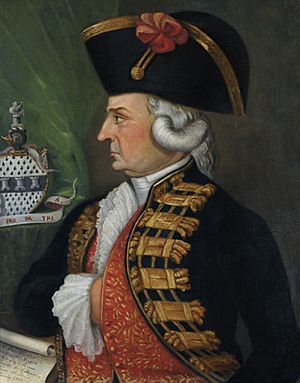
Bernardo O'Higgins was born in Chillán, Chile, in 1778. His father was Ambrosio O'Higgins, 1st Marquis of Osorno, a Spanish officer from Ireland. Ambrosio later became the governor of Chile and then the viceroy of Peru. Bernardo's mother was Isabel Riquelme, a well-known local woman.
Bernardo grew up with his mother's family. His father supported him financially but they never met. When Bernardo was 15, his father sent him to Lima for his education. Later, he went to London to continue his studies. In London, he learned about ideas of independence for countries. He met Francisco de Miranda, a Venezuelan who believed in freedom. Bernardo joined a secret group that wanted to make Latin America independent.
In 1802, O'Higgins returned to Chile. He took his father's last name and became a farmer. In 1808, Napoleon took control of Spain. This caused many changes in South America. In Chile, local leaders decided to create their own government. This was a big step towards Chile's independence. O'Higgins played a major role in this movement.
Fighting for Chile's Freedom
On September 18, 1810, O'Higgins joined the fight against Spanish rule. Chilean leaders did not want to be ruled by Napoleon's brother. They formed a temporary government to support the Spanish king. This day is now celebrated as Chile's Independence Day.
O'Higgins became a deputy in Chile's first National Congress of Chile in 1811. He was a strong supporter of independence. However, the leaders who wanted independence were not always united. There were rival groups, especially between leaders from Santiago and Concepción.
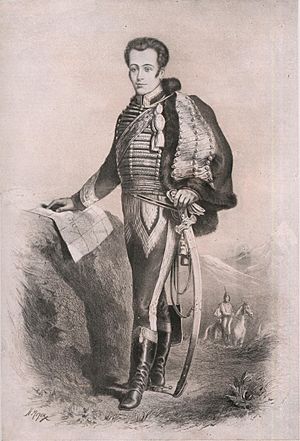
O'Higgins often had disagreements with José Miguel Carrera. Carrera was a powerful leader from Santiago. O'Higgins's support came from Concepción. In 1813, Spain tried to take back control of Chile. Carrera was the army's commander. O'Higgins joined the fight and showed great courage. He won a battle at Linares and was promoted to colonel.
O'Higgins was known for his brave fighting style. He often fought with great determination. After some battles, the leadership of the army changed. O'Higgins was given command instead of Carrera. This made their rivalry even stronger.
In 1814, royalist forces attacked again. O'Higgins and Carrera decided to work together against the common enemy. They planned to defend a narrow gorge. However, O'Higgins decided to defend the town of Rancagua instead. Carrera did not arrive with help, and O'Higgins's forces were surrounded. This was a difficult defeat.
After this loss, O'Higgins and other Chilean patriots went to Argentina. They stayed there for three years while Spain controlled Chile again.
O'Higgins Becomes Supreme Director
While in Argentina, O'Higgins met José de San Martín. San Martín was a famous Argentine general. Together, they planned to free Chile. In 1817, they led their armies back into Chile. They won a major victory at the Battle of Chacabuco.
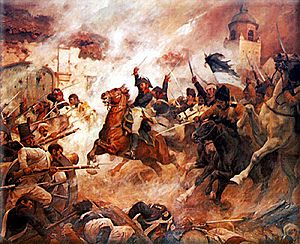
During the Battle of Chacabuco, O'Higgins showed his bravery. He charged with his troops even before planned. San Martín had to adjust his strategy to support O'Higgins. Their combined efforts led to a big win for the patriots. This battle was very important for Chile's independence.
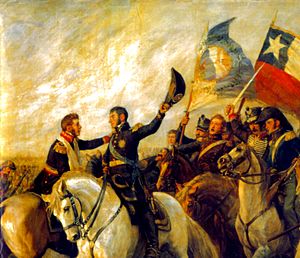
After some more fighting, including a royalist victory at Second Battle of Cancha Rayada, the patriots won the final battle at Battle of Maipú in 1818. This victory secured Chile's independence. San Martín was offered the leadership of Chile, but he wanted to continue fighting for freedom in other parts of South America. So, O'Higgins accepted the role.
On February 16, 1817, Bernardo O'Higgins became the first leader of independent Chile. He was given special powers as the Supreme Director. On February 12, 1818, Chile officially declared itself an independent republic.
Leading Independent Chile
For six years, O'Higgins led Chile. His government made many improvements. He helped create markets, courts, colleges, and hospitals. He also worked to improve farming.
O'Higgins also focused on strengthening Chile's military. He founded the Chilean Military Academy in 1817. He also created the modern Chilean Navy. He hired a Scottish officer, Lord Cochrane, to lead the navy. O'Higgins believed that controlling the sea was vital for Chile's safety. He even sent forces to help San Martín free Peru.
However, over time, O'Higgins started to lose support. He proposed new ideas like democracy and ending noble titles. These ideas were not popular with powerful landowners. He also upset the church. His government also ran out of money. A big earthquake added to the country's problems.
In 1822, O'Higgins introduced a new constitution. Many people thought this was his way of trying to stay in power. Some people also blamed him for the deaths of his political rivals. The different regions of Chile felt he was taking too much power for himself.
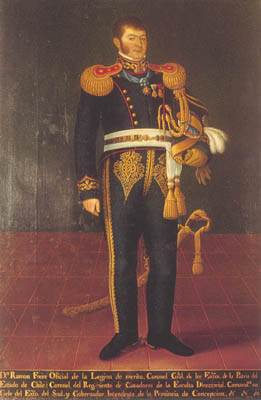
On January 28, 1823, O'Higgins was removed from power. Ramón Freire, who had been his ally, took his place. O'Higgins left Chile in July 1823 and never returned.
Life in Exile and Legacy
O'Higgins went to Peru after leaving Chile. He was encouraged by Simón Bolívar, another great South American liberator. Bolívar gave O'Higgins land in Peru. O'Higgins lived there with his son, mother, and half-sister.
He wanted to join Bolívar's army to help free Peru. However, Bolívar did not give him a command. O'Higgins still celebrated the final victory in Peru. He said, "America is free. From now on General O'Higgins does not exist; I am only Bernardo O'Higgins, a private citizen."
Later, the Chilean government honored O'Higgins again. They gave him back his old military rank. In 1842, the Chilean Congress voted to allow him to return home. But O'Higgins was too sick to travel. He died in Lima, Peru, on October 24, 1842, at age 64.
Remembering O'Higgins
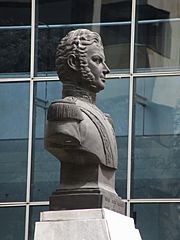
Bernardo O'Higgins is remembered as a hero in Chile and other countries. His body was first buried in Peru, then moved to Chile in 1869. Today, his remains are in a special crypt in Santiago.
Many places are named after him. One of Chile's regions is called Libertador General Bernardo O'Higgins Region. The main street in Chile's capital, Santiago, is Avenida Libertador General Bernardo O'Higgins. There is also a Bernardo O'Higgins National Park.
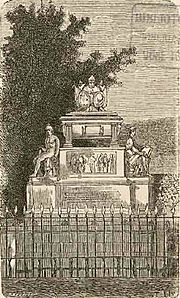
You can find statues and busts of O'Higgins around the world. There's one in London, where he studied. There are also busts in Dublin and Sligo, Ireland, because of his Irish family background. In Buenos Aires, Argentina, there is a large statue of him.
The Order of Bernardo O'Higgins is Chile's highest award for foreign citizens. It is named in his honor. The Chilean Navy has named several ships after him, including frigates, corvettes, cruisers, and a submarine. There is also a Chilean research station in Antarctica named Base General Bernardo O'Higgins Riquelme.
In 2010, the post offices of Ireland and Chile issued stamps to honor O'Higgins and Juan Mackenna. These stamps marked 200 years since Chile's fight for independence began.
See also
 In Spanish: Bernardo O'Higgins para niños
In Spanish: Bernardo O'Higgins para niños



